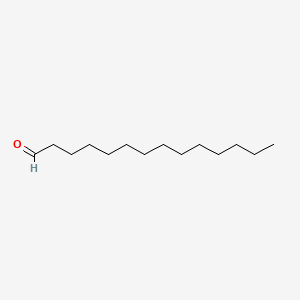| MeSH term | MeSH ID | Detail |
|---|---|---|
| Melanoma | D008545 | 69 associated lipids |
| Fibrosarcoma | D005354 | 8 associated lipids |
| Dermatitis, Toxicodendron | D011040 | 3 associated lipids |
Myristaldehyde
Myristaldehyde is a lipid of Fatty Acyls (FA) class. The involved functions are known as myristoylation and Cytokinesis of the fertilized ovum. The related lipids are 3-hydroxypalmitic acid.
Cross Reference
Introduction
To understand associated biological information of Myristaldehyde, we collected biological information of abnormalities, associated pathways, cellular/molecular locations, biological functions, related genes/proteins, lipids and common seen animal/experimental models with organized paragraphs from literatures.
What diseases are associated with Myristaldehyde?
There are no associated biomedical information in the current reference collection.
Possible diseases from mapped MeSH terms on references
We collected disease MeSH terms mapped to the references associated with Myristaldehyde
PubChem Associated disorders and diseases
What pathways are associated with Myristaldehyde
There are no associated biomedical information in the current reference collection.
PubChem Biomolecular Interactions and Pathways
Link to PubChem Biomolecular Interactions and PathwaysWhat cellular locations are associated with Myristaldehyde?
There are no associated biomedical information in the current reference collection.
What functions are associated with Myristaldehyde?
Related references are published most in these journals:
| Function | Cross reference | Weighted score | Related literatures |
|---|
What lipids are associated with Myristaldehyde?
Related references are published most in these journals:
| Lipid concept | Cross reference | Weighted score | Related literatures |
|---|
What genes are associated with Myristaldehyde?
There are no associated biomedical information in the current reference collection.
What common seen animal models are associated with Myristaldehyde?
There are no associated biomedical information in the current reference collection.
NCBI Entrez Crosslinks
All references with Myristaldehyde
Download all related citations| Authors | Title | Published | Journal | PubMed Link |
|---|---|---|---|---|
| Swimm AI and Kalman D | Cytosolic extract induces Tir translocation and pedestals in EPEC-infected red blood cells. | 2008 | PLoS Pathog. | pmid:18208322 |
| Günther S et al. | Apicoplast lipoic acid protein ligase B is not essential for Plasmodium falciparum. | 2007 | PLoS Pathog. | pmid:18069893 |
| Shenderov AN et al. | [Effect of amino acids on the luminescent system induction in Photobacterium belozerskii]. | 1980 Mar-Apr | Prikl. Biokhim. Mikrobiol. | pmid:7384006 |
| Hayashi N and Titani K | N-myristoylated proteins, key components in intracellular signal transduction systems enabling rapid and flexible cell responses. | 2010 | Proc. Jpn. Acad., Ser. B, Phys. Biol. Sci. | pmid:20467215 |
| Schröder T et al. | The myristoylation of guanylate cyclase-activating protein-2 causes an increase in thermodynamic stability in the presence but not in the absence of Ca²âº. | 2011 | Protein Sci. | pmid:21520322 |
| Hayashi N et al. | Nef of HIV-1 interacts directly with calcium-bound calmodulin. | 2002 | Protein Sci. | pmid:11847276 |
| Matsubara M et al. | Myristoyl moiety of HIV Nef is involved in regulation of the interaction with calmodulin in vivo. | 2005 | Protein Sci. | pmid:15632291 |
| Dennis CA et al. | Co-translational myristoylation alters the quaternary structure of HIV-1 Nef in solution. | 2005 | Proteins | pmid:16021629 |
| Gensch T et al. | Ca2+-dependent conformational changes in the neuronal Ca2+-sensor recoverin probed by the fluorescent dye Alexa647. | 2007 | Proteins | pmid:17078090 |
| Xu X et al. | Conformational dynamics of recoverin's Ca2+-myristoyl switch probed by 15N NMR relaxation dispersion and chemical shift analysis. | 2011 | Proteins | pmid:21465563 |
